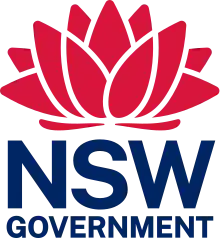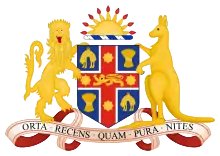Government of New South Wales
The Government of New South Wales, also known as the NSW Government, is the democratic administrative authority in New South Wales, Australia, and is empowered by the state Constitution. Since Federation in 1901, New South Wales has been a state of Australia, and the federal Constitution regulates its relationship with the Commonwealth. Under the Australian Constitution, all states ceded legislative and judicial supremacy, but retained powers in all matters not in conflict with the Commonwealth.
| State Government | |
  The New South Wales Government logo used to corporately identity the executive government and its agencies (top); and the Coat of Arms of New South Wales, used across the government, including the non-executive arms (bottom) | |
| Formation |
|
|---|---|
| Founding document | Constitution of New South Wales |
| State | New South Wales |
| Country | Australia |
| Website | nsw |
| Crown | |
| Head of state (sovereign) | Monarch (King) |
| Vice-regal representative | Governor |
| Seat | Government House |
| Legislative branch | |
| Legislature | Parliament of New South Wales |
| Meeting place | Parliament House |
| Executive branch | |
| Head of government | Premier |
| Main body | New South Wales Ministry |
| Appointed by | Governor on behalf of the King of Australia |
| Headquarters | Chief Secretary's building, Sydney |
| Main organ | Executive Council |
| Departments | 10 departmental clusters |
| Judicial branch | |
| Court | Supreme Court |
| Seat | Law Courts Building |
There are 10 'clusters' of the NSW Government, as well as a large number of supporting agencies, authorities, commissions and other public bodies. These clusters (for example, NSW Health) are typically led by a ministerial department (Ministry of Health, etc.) and supported by government agencies and organisations (such as Local Health Districts, HealthShare NSW or the Agency for Clinical Excellence). There are also independent structures, such as the Electoral Commission or the Independent Commission Against Corruption, that oversee the integrity of democratic processes.
The current government is held by the state division of the Australian Labor Party (New South Wales Branch). The current premier is Chris Minns, who succeeded Dominic Perrottet on 25 March 2023 following the 2023 New South Wales state election on 25 March 2023.
Executive and judicial powers
New South Wales is governed according to the principles of the Westminster system, a form of parliamentary government based on the model of the United Kingdom. Legislative power rests with the Parliament of New South Wales, which consists of the Crown, represented by the Governor of New South Wales, and the two Houses, the New South Wales Legislative Council (the upper house) and the New South Wales Legislative Assembly (the lower house). Executive power rests formally with the Executive Council, which consists of the Governor and senior ministers.[1]
The Governor, as representative of the Crown, is the formal repository of power, which is exercised by him or her on the advice of the Premier of New South Wales and the Cabinet. The Premier and Ministers are appointed by the Governor, and hold office by virtue of their ability to command the support of a majority of members of the Legislative Assembly. Judicial power is exercised by the Supreme Court of New South Wales and a system of subordinate courts, but the High Court of Australia and other federal courts have overriding jurisdiction on matters which fall under the ambit of the Australian Constitution.
In 2006, the Sesquicentenary of Responsible Government in New South Wales, the Constitution Amendment Pledge of Loyalty Act 2006 No. 6 was enacted to amend the Constitution Act 1902 to require Members of the New South Wales Parliament and its Ministers to take a pledge of loyalty to Australia and to the people of New South Wales instead of swearing allegiance to the Queen her heirs and successors, and to revise the oaths taken by Executive Councillors.[2] The Act was assented to by the Queen on 3 April 2006.
On 5 June 2012, the Constitution Amendment (Restoration of Oaths of Allegiance) Act 2012 No 33 was assented to and made a further amendment to the Constitution Act 1902, by restoring the option of taking the oath of allegiance to the Queen, her heirs and successors, in addition to the option of taking the pledge of loyalty.[3] The change applies to members of Legislative Council, Legislative Assembly and Executive Council.
Ministries
The following individuals serve as government ministers, at the pleasure of the King, represented by the Governor of New South Wales. The government ministers are listed in order of seniority as listed on the Parliament of New South Wales website and were sworn on by the Governor with effect from 5 April 2023, while their opposition counterparts are listed to correspond with the government ministers.[4] All Opposition counterparts are members of the Parliament of New South Wales.
| Office | Minister |
|---|---|
| Chris Minns MP | |
| Prue Car MP | |
| Penny Sharpe MLC | |
|
John Graham MLC |
| Daniel Mookhey MLC | |
| Ryan Park MP | |
| Jo Haylen MP | |
| Paul Scully MP | |
| Sophie Cotsis MP | |
| Yasmin Catley MP | |
| Jihad Dib MP | |
| Kate Washington MP | |
| Michael Daley MP | |
| Tara Moriarty MLC | |
| Ron Hoenig MP | |
| Courtney Houssos MLC | |
| Steve Kamper MP | |
| Rose Jackson MLC | |
| Anoulack Chanthivong MP | |
| Tim Crakanthorp MP | |
| David Harris MP | |
| Jodie Harrison MP |
See also
References
- "The Executive Council". www.parliament.nsw.gov.au. Retrieved 31 January 2018.
- Pledge of Loyalty Act 2006 (NSW)
- "Constitution Amendment (Restoration of Oaths of Allegiance) Bill 2012". Legislation NSW. 5 June 2012. Retrieved 26 June 2019.
- "Shadow Ministry". Members. Parliament of New South Wales. January 2017. Retrieved 19 January 2018.
External links
- Government of New South Wales website
- New South Wales Government Annual Reports and Other Publications
- The Constitution of New South Wales
